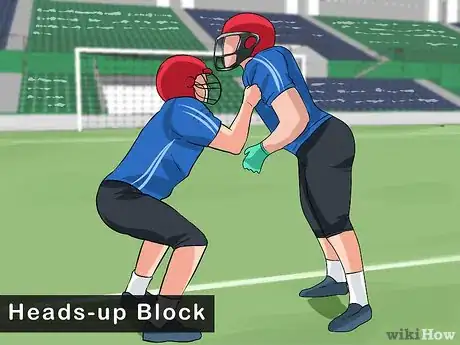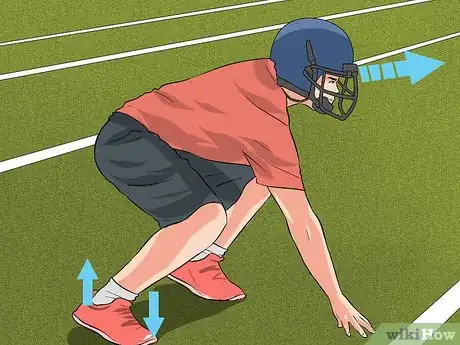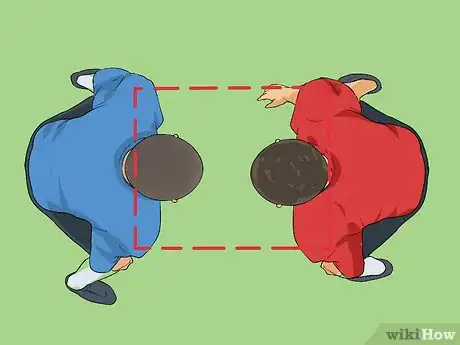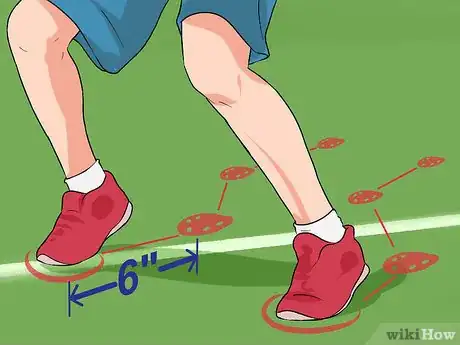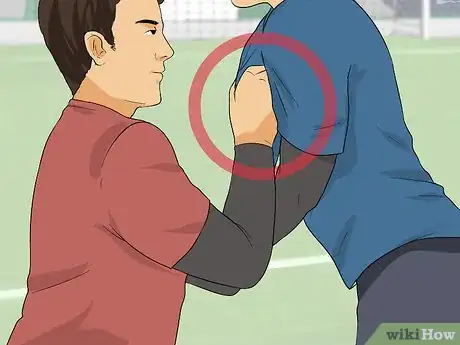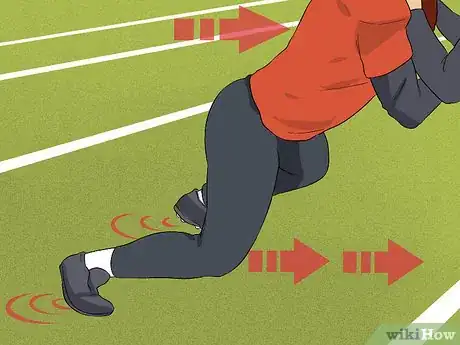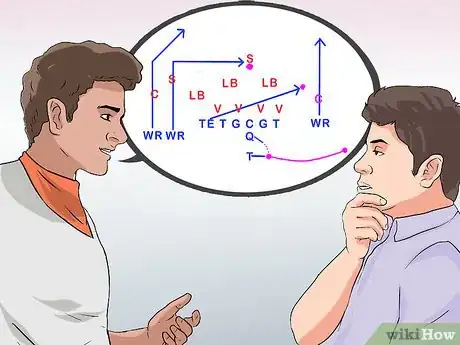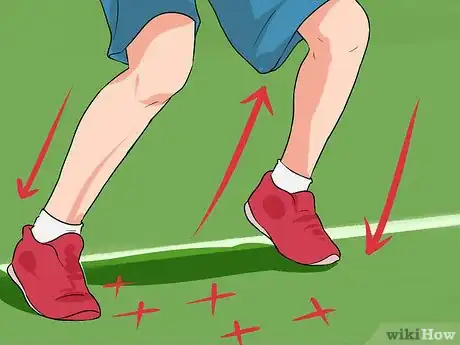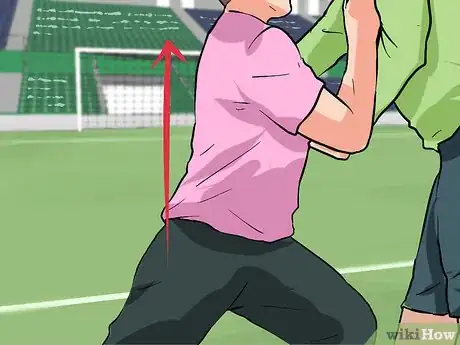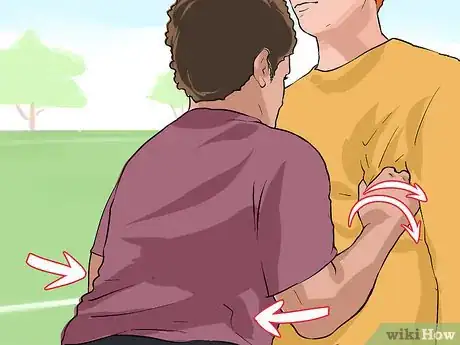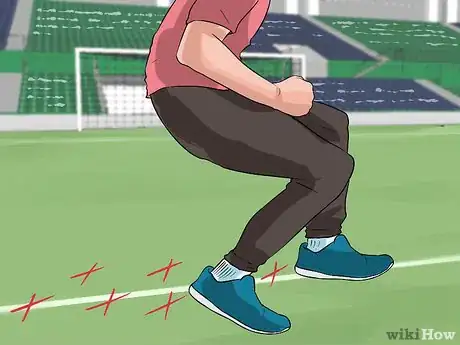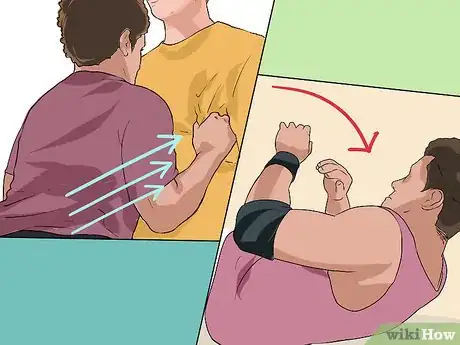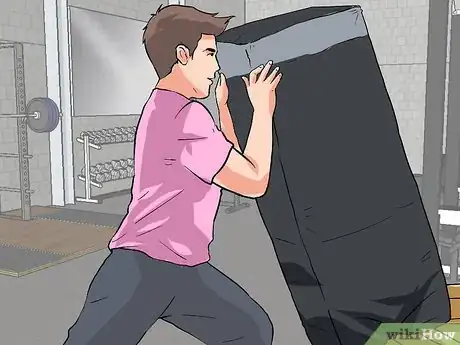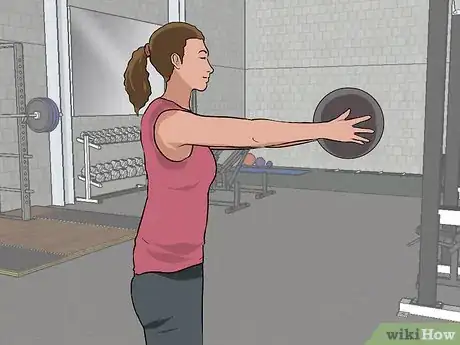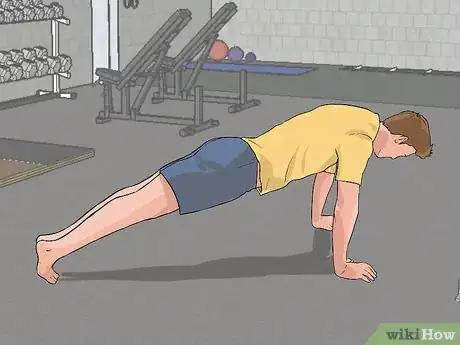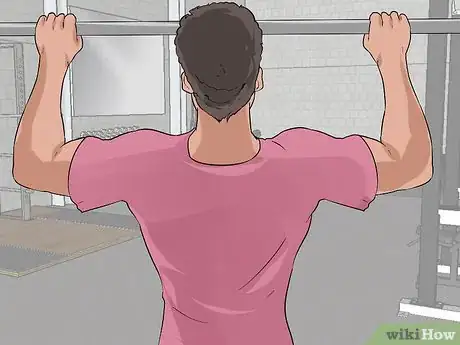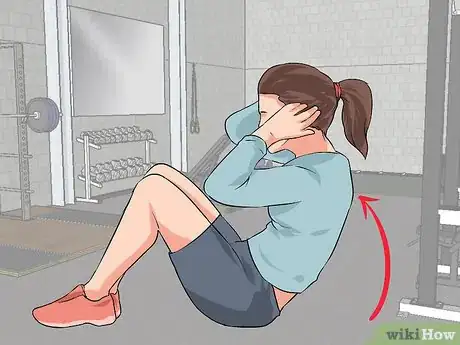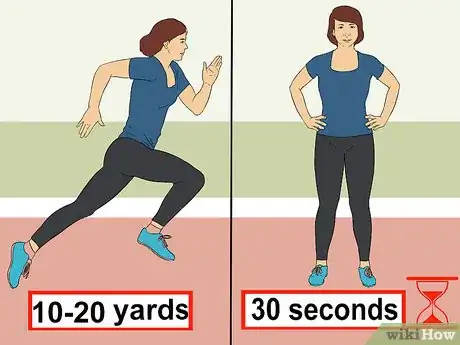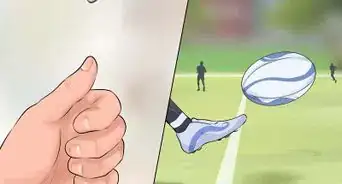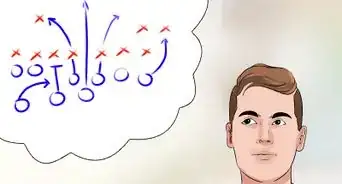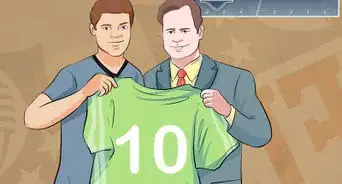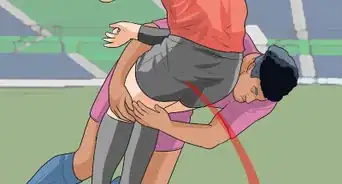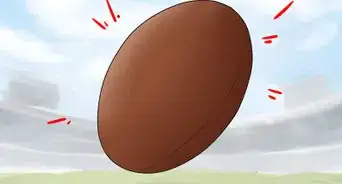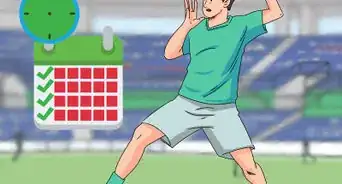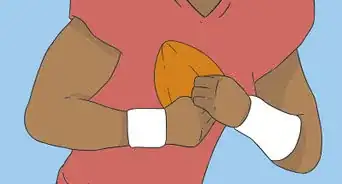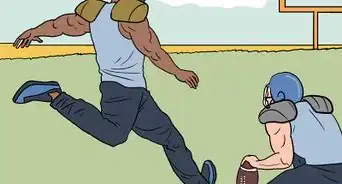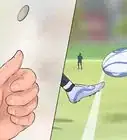This article was co-authored by wikiHow Staff. Our trained team of editors and researchers validate articles for accuracy and comprehensiveness. wikiHow's Content Management Team carefully monitors the work from our editorial staff to ensure that each article is backed by trusted research and meets our high quality standards.
There are 8 references cited in this article, which can be found at the bottom of the page.
This article has been viewed 72,881 times.
Learn more...
Blocking is crucial for a solid offense. It helps protect the quarterback when passing and makes holes for running backs to run through on rushing plays. Failure to block will cause any offense to crumble. But a good blocking game is one thing that will put your team in a position to win every time you take the field.
Steps
Mastering Heads Up Blocking
-
1Use the techniques and style of a heads-up block for most blocking scenarios. This is the most common block in football, and all the rest, from cut-off blocks to trap blocks, stem from these fundamentals. A block has five distinct parts -- the stance, the run-up, the strike, the stick, and the follow-through. These five parts can be used whether you're a lineman or a running back, depending on the play and your coach's instructions.[1]
-
2Start in an athletic, powerful three-point stance. This stance is the base of every block, and how you'll line up on the line before every play. Getting it right is not about looking good -- it is about maximizing speed and power right off the whistle. Remember:
- Feet shoulder width apart, up on the balls of your feet, not your heels.
- Knees bent and slightly in front of your ankles.
- Bent at the waist, never the back. Your spine should form a straight, diagonal line.
- Dominant hand on the ground for balance and support. The other hand is low, parallel to the ground.
- Eyes up, looking at your target.[2]
Advertisement -
3Use your first step to line your shoulders squarely with the man you're blocking. Your first step is short, using your non-dominant foot (left foot if you're right-footed) to get yourself into position. It should be a roughly 6-inch step, shifting your weight to effectively close off the running lane. You want your shoulders to match up evenly with your opponent's shoulders.
- Stay on your toes with every step instead of going flat-footed.
- Remember to keep your head up throughout the block, locking your eyes on your opponent.
-
4Take a short, powerful step into your opponent as you make contact. Your first step sets up your line, the second drives you into the block. Use your dominant foot for extra power, taking short, 6-inch steps that keep your knees slightly bent and powerful.
- Shorter steps are more powerful, and you can get them in much faster than long, loping strides. This is why so many football coaches do ladder and tire drills to increase foot speed.[3]
-
5Drive your palms just inside your opponent's armpits as you make contact. Don't launch forward with your hands already extended. Rather, as you're making contact with that second step, drive your palms right below the shoulder pads, roughly between the numbers and armpits. You want this explosive contact to drive them back.
- Your head is still up, not leading with the top of your head into the opponent. This is both dangerous and illegal.
-
6Keep your feet moving to "roll" your hips into the opponent. As you hands make contact, you'll likely be slowed by the resistance of the opposing blocker. Keep your feet moving with short, choppy steps as you bring your hips in closer to the opponent, keeping your knees bent and your butt low for power. Think of moving the hips forwards and upwards as you connect, continuing your contact forward.
-
7Push up and forward to drive the opponent backward. Pushing slightly upward takes the opponent off their feet, lowering their power considerably. This is why, when you rolled your hips under, you kept your knees bent for propulsive power up and out.
-
8Keep your feet moving, driving forward until you hear the whistle. You must keep your block up throughout the play, as you likely don't know what is happening behind you. While you might not be able to drive upfield, keep your feet moving. Drive into the defender to remove him from the play until you hear the whistle.[4]
- Note-- on a pass play, you don't want to drive all the way up, you want to hold your line to protect the quarterback.
Perfecting Your Block Technique
-
1Know your plays inside and out. The best blocking technique in the world doesn't mean squat if you don't know who you're blocking. You should know what is required of you in every play and scenario, so spend some time doing your homework. If you have questions, ask your coaches -- don't wait until game time to get the plays down. Most importantly, know whether it is a running play or passing play:
- Running plays are when you drive into the defense to make as big a hole as possible, pushing back hard.
- Pass blocking is when you stay on your line and keep the opponent from getting to the quarterback. You must hold position.
- On a play-action pass play, there is a fake run, so fire off as if run blocking but don't go down field, holding your line instead.[5]
-
2Always keep your feet chopping forward with short, powerful steps. Even if you've got your opponent beat, the blocker that keeps their feet moving is usually the one that wins in the end. Furthermore, you have far more power in your legs than your arms, and your upper body will tire out much faster than your lower over the course of a full game.
- Your knees should always be bent while blocking.
- Remember -- short, explosive steps off the balls of your feet-- keep moving.[6]
-
3Keep your spine straight to avoid injuries and add power. One of the biggest and most dangerous blocking mistakes you can make is bending your back, putting excess strain on your spine and greatly lowering power. When crouching, you want to bend from the waist while keeping your spine straight. As you make contact, lean forward from the waist while keeping your back broom-handle straight.
- Strong back and core muscles will help you do this, gaining a key advantage over opponents.[7]
-
4Tuck your elbows in, hands rotated slightly outward, for maximum power. Keep your elbows close to your ribs as you make contact, as this maximizes the power of your arms. Rotating your arms slightly to the outside should also square your biceps up with the opponent, further increasing power.
- To help remember where to place your hands, think of pointing your thumbs straight up to the sky.[8]
-
5Use short, powerful approach steps to close the distance on any far-off blocks. Not all blocks come right off the line. Sometimes you'll need to move forward to approach your opponent. When doing so, don't just run up like normal. From about 10-12 feet out, drop your hips and take the short, choppy steps of a normal block, staying on the balls of your feet. You should be able to change directions on a dime, trying to line your shoulders up with his as you land the block.
- This also applies as a defender is rushing towards you. Use your short steps to keep your shoulders square to his, then drive forward as he makes contact with you.
- Running directly at someone is the best way to get faked out, as you can't change direction fast enough to react.[9]
-
6Keep shoving your hands as you press, wanting nothing more than to see your opponent on the ground. You should want to physically dominate every single opponent that crosses your path. Don't neglect the mental portion of the game -- the most ruthless and aggressive blocker will always have the advantage. Short of holding or grabbing a jersey, use your hands to manhandle your opponent into submission.
- Once you've made contact, your hands don't have to stop. Violent, short pushes and shoves can knock them off their feet and help you drive through.[10]
Training For Blocking Power
-
1Use a blocking sled to mimic game-like motions. The best way to become a stronger blocker is to block. While you cannot only block without ever going to the gym, regular blocking exercises must be a part of your workouts. For an added challenge, have people stand on the back of the sled to add weight.
- Always focus on your form when practicing. The better it is in practice, the better it will be in a game.
-
2Use squats to gain the explosive lower-body power needed for success. Squatting closely mimics the act of pressing up and out on a defender, making it an essential exercise for any blocker. Regular squats are important, but there are also blocker-specific variations that you can use once a week to mix things up:
- Paused-Front Squat: Using a lower weight than normal, set up for a normal squat. As you lower, hold the bottom position for three seconds. Then explode upwards with the weight.
- Dead-Stop Squat: Lower the bar's starting position so that your thighs are slightly higher than parallel to the ground. Get ready under the bar, then simply explode upward. Slowly lower it back to the bar, resting it completely, to finish one rep.[11]
-
3Use medicine ball training to build explosive upper body strength. Medicine balls, especially those that bounce, are an excellent way to build game-like power in the gym. Start each exercise in a squat position, keeping your knees bent and over your ankles, to mimic your game posture. You can then try:
- Medicine Ball Leaps: Launch yourself forward from the squat, throwing the ball directly in front of you as you do. Try to mimic the feeling of exploding into a defender while shoving your arms out for the best results. Land, pickup the ball and repeat.
- Repeated Throws: Standing near a wall in squat position, throw the ball into the wall so that it bounces back to your chest. Keep your lower body still the entire time, stringing together as many throws and catches as you can.[12]
-
4Build a powerful chest with bench presses, push-ups, and chest flies. Your chest muscles activate when you push your arms in front of you, making their usefulness in blocking obviously. Bench pressing and push-ups are the most common and useful exercises, but not the only ones. You should dedicate 2-3 days a week to a strong chest.
- Use incline and decline presses to work different areas of your chest muscles.
- Try "plyometric pushups," where you must jump off the ground with your hands and clap in front of your face, for truly explosive power.[13]
-
5Develop back and core strength with pull-ups, rows, and deadlifts. A strong back isn't always noticeable, but it adds serious power throughout your block by keeping you upright, strong, and dense. No matter what exercises your prefer, the following three compound exercises are essential for unbeatable blockers.
-
6Focus on your abs and core at least twice a week for better form and power. Your core helps you keep your back strong and straight. Furthermore, you transfer power from your legs to your upper body through your core, and strong central muscles make all of your movements more efficient. Try out:
- Planks/Bridges
- Sit-ups
- Crunches
- Leg lifts.
-
7Keep any conditioning short and sprint-based, not jogging. Jogging is nothing by a cool-down or warm-up for you. You don't jog on the field as a blocker, you do make tons of short, high-intensity sprints. You should train this way as well. Try out:
- Ladder or tire drills that require quick feet for a short amount of time.
- 10-20 yard sprints, resting for only 30 seconds between each.
- Position sprints -- line up against a bag, or no one, and then "block" for 5 seconds. Then turn and sprint downfield for 10 yards as if you were following a play.[14]
Community Q&A
-
QuestionCan you grab the defender's legs and lay him out?
 DonaganTop AnswererNo. That's a tackle, and offensive players are not allowed to tackle defensive players.
DonaganTop AnswererNo. That's a tackle, and offensive players are not allowed to tackle defensive players. -
QuestionCan a defender punch the rusher in the gut?
 Dabomb1Community AnswerNo. That is illegal and will get you ejected.
Dabomb1Community AnswerNo. That is illegal and will get you ejected. -
QuestionIf I hold my hands under the guy's chest plate for the remainder of that play, is that holding?
 Community AnswerIt depends on whether the guy is parallel with the sidelines and in front of the QB or not.
Community AnswerIt depends on whether the guy is parallel with the sidelines and in front of the QB or not.
Warnings
- Never ram your opponent with your head, you risk becoming paralyzed. Keep your eyes up.⧼thumbs_response⧽
- Avoid clipping. That is when you hit the defender's back and is a 15 yard (13.7 m) penalty.⧼thumbs_response⧽
- Don't grab the face mask. That is a 15 yard (13.7 m) penalty.⧼thumbs_response⧽
Things You'll Need
- Football helmet
- Pads
References
- ↑ http://usafootball.com/health-safety/how-to-block
- ↑ http://www.active.com/football/articles/the-3-stances-of-offensive-linemen
- ↑ http://usafootball.com/health-safety/how-to-block
- ↑ http://usafootball.com/health-safety/how-to-block
- ↑ http://youthfootballonline.com/offensive-line-blocking-techniques
- ↑ http://youthfootballonline.com/offensive-line-blocking-techniques
- ↑ http://www.stack.com/a/pass-blocking-techniques
- ↑ http://www.stack.com/a/pass-blocking-techniques
- ↑ http://youthfootballonline.com/offensive-line-blocking-techniques
- ↑ https://coachparker.org/2011/07/26/hands-are-your-weapons-in-youth-football-blocking/
- ↑ http://www.stack.com/a/offensive-lineman-workout
- ↑ http://www.stack.com/a/offensive-lineman-workout
- ↑ http://www.elitefts.com/education/training/seven-steps-for-building-the-perfect-high-school-lineman/
- ↑ http://www.elitefts.com/education/training/seven-steps-for-building-the-perfect-high-school-lineman/
